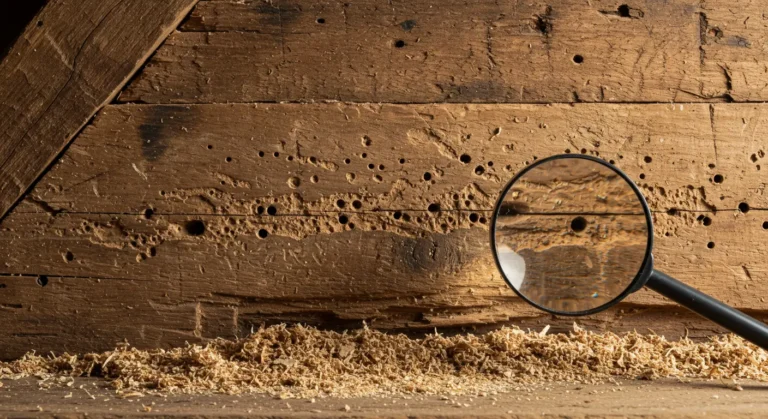How Do You Know If Woodworm Is Active?
Woodworm might sound like something out of a medieval pest problem, but trust us—this wood-munching menace is alive and boring (literally!) through UK homes today. If you’re asking “how do you know if woodworm is active?”, you’ve already taken the first smart step. Early detection is key to preventing major damage to wooden furniture, beams, and even structural timbers.
🐛 What Is Woodworm?
“Woodworm” refers to the larvae of wood-boring beetles—insects that lay eggs inside wood. When these eggs hatch, the larvae burrow through the wood, feeding on it for several years before emerging as adult beetles. In the UK, the most common culprits are the Common Furniture Beetle, Deathwatch Beetle, and Powderpost Beetle.
Though tiny, these pests can cause structural damage, and catching them while they’re still active can save you serious money and hassle.
🔍 7 Signs Woodworm Is Active
Here’s how to know if you have an active woodworm infestation:
1. Fresh Exit Holes
The most obvious clue? Small, round holes in wood surfaces. Fresh holes mean the larvae have just transformed into beetles and chewed their way out. The wood around these holes will appear clean and light in colour, as it hasn’t aged yet.
2. Powdery Dust (Frass)
This is a surefire sign. Frass is the fine, sawdust-like powder left behind by woodworm as they burrow. If you spot this around holes or on the floor, chances are you have a current infestation.
3. Live Beetles or Dead Ones Nearby
Seeing adult beetles crawling out of the wood (especially during warmer months) or finding dead ones near wooden items strongly suggests that the woodworm life cycle is still active.
4. Crumbly Edges or Damaged Timbers
Check roof beams, skirting boards, floorboards, and even antique furniture. If the wood crumbles easily, feels weak, or sounds hollow when tapped—woodworm might be inside.
5. Tunnels in the Wood
If you break open a piece of timber and notice tiny tunnels winding through it, this is classic wood-boring insect damage.
6. Clicking Noises
Some species, like the Deathwatch Beetle, make a faint clicking noise inside the wood as they tap to attract mates. Creepy, but a useful sign!
7. Increased Activity in Warm, Humid Weather
In the UK, woodworm activity often spikes during spring and summer, especially in damp environments like basements, attics, and older homes.
🏡 Why Woodworm Infestation Happens in the UK
The UK’s damp climate is a breeding ground for wood-boring insects. Poor ventilation, untreated timber, and high humidity create the perfect conditions for larvae to thrive. Add in older buildings with wooden beams and floorboards, and you’ve got yourself a prime target for woodworm infestation.
🔎 How to Check for Wood Boring Insects
If you’re not sure, here’s how to do a simple inspection:
- Use a flashlight and a flat-head screwdriver.
- Tap the wood. Hollow sounds = red flag.
- Look closely at attic beams, under floorboards, and behind furniture.
- Mark any exit holes with a pencil and check back in a few weeks. New holes mean activity.
💡Pro tip: Call a pest control expert if you’re unsure. Professionals use moisture meters and endoscopes to detect hidden infestations.
🧯 What to Do If You Spot Woodworm
Don’t panic—but don’t ignore it either. Follow these steps:
- Isolate the affected item if possible (especially furniture).
- Avoid DIY over-the-counter sprays unless the infestation is clearly surface-level.
- Call a licensed woodworm treatment specialist. They’ll assess the damage, identify the beetle type, and offer solutions.
- Depending on severity, treatment may include:
- Insecticidal sprays
- Surface treatments
- Fogging
- Fumigation (for serious infestations)
- Wood replacement (for structural damage)
🔐 Preventing Future Woodworm Attacks
Once treated, make your home a woodworm-free fortress:
- Keep humidity low (under 60%) with dehumidifiers or better ventilation.
- Treat new wood with insecticides before use.
- Inspect regularly, especially in spring and summer.
- Fix leaks, damp patches, or poor insulation that lead to moisture buildup.
❓ FAQs: Woodworm Detection and Treatment
Q1: How long does woodworm live inside the wood?
Woodworm larvae can live for 2–5 years inside the timber before emerging as beetles.
Q2: Is it dangerous to ignore woodworm?
Yes. Left untreated, woodworm can weaken structural beams, leading to expensive repairs or even safety risks.
Q3: Can I treat woodworm myself?
You can for minor cases, using specialized woodworm treatment products. But for large infestations, call a professional.
Q4: Does furniture with woodworm need to be thrown away?
Not always. If caught early, woodworm-damaged furniture can be treated and preserved.
Q5: Are woodworms seasonal in the UK?
Yes, most active during April to September. That’s when you’re likely to see beetles and fresh exit holes.
Read More : How to Avoid Buying American Products: 10 Smart & Easy Tips for UK Shoppers
✅ Final Thoughts
So, how do you know if woodworm is active? You check, listen, feel, and observe. These pests are sneaky, but if you catch the signs of woodworm early, you can save your wood, your money, and your sanity.

